Strategic Human Resource Management Essay: Problems and Strategies
VerifiedAdded on 2021/04/21
|14
|3470
|121
Essay
AI Summary
This essay delves into the realm of Strategic Human Resource Management (SHRM), examining the common problems organizations face, such as recruitment and selection complexities, employee training and development deficiencies, performance management system inadequacies, and the challenges of employee retention and succession planning. It explores the impact of these issues on organizational performance and profitability. Furthermore, the essay outlines the strategic roles HR can play in addressing these challenges, emphasizing talent management, careful selection processes, and the importance of training and development for employee growth. It also highlights the significance of effective performance management systems and career planning for long-term employee value and retention, providing practical recommendations for improved HR practices. This document is contributed by a student and available on Desklib, a platform offering AI-powered study tools.
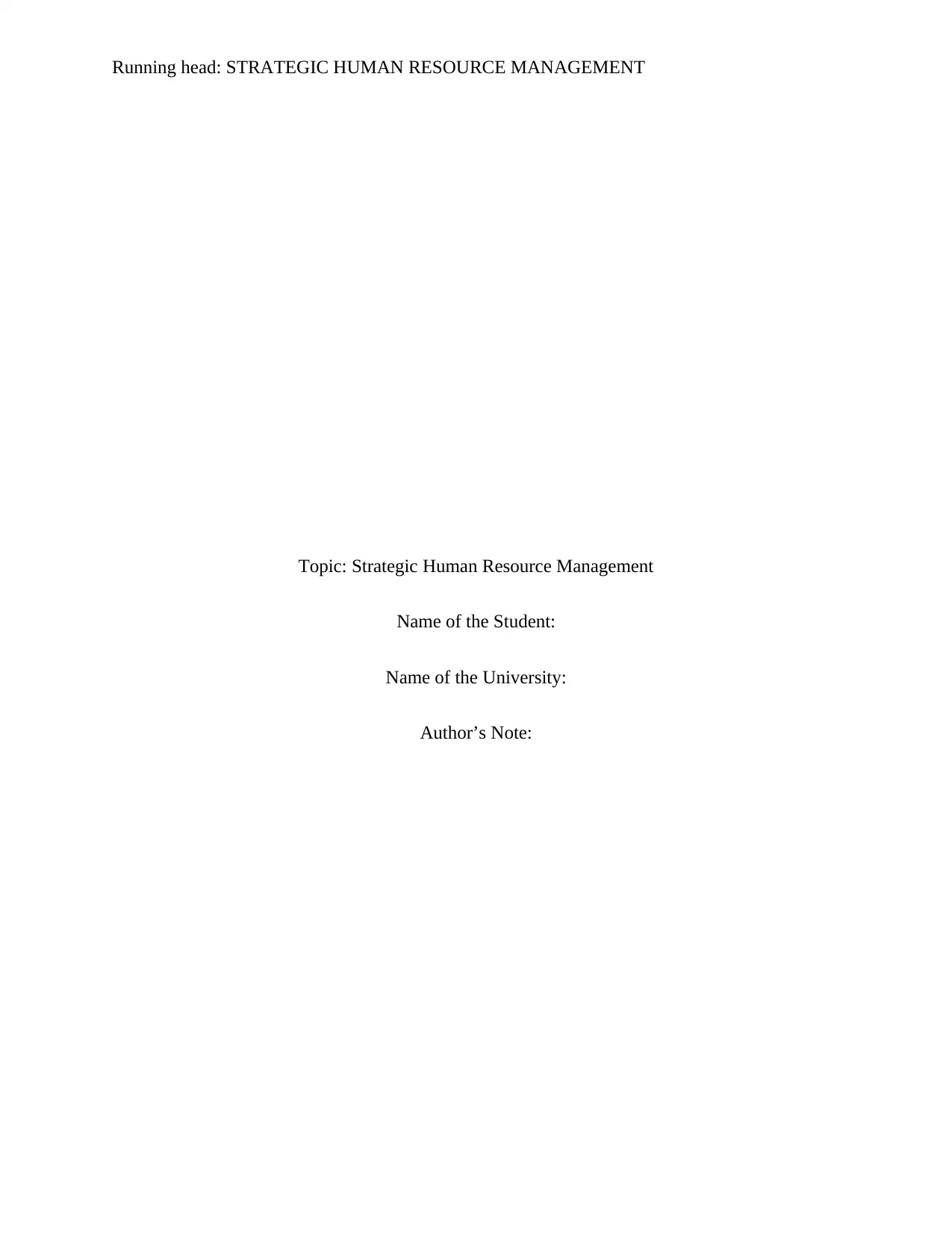
Running head: STRATEGIC HUMAN RESOURCE MANAGEMENT
Topic: Strategic Human Resource Management
Name of the Student:
Name of the University:
Author’s Note:
Topic: Strategic Human Resource Management
Name of the Student:
Name of the University:
Author’s Note:
Paraphrase This Document
Need a fresh take? Get an instant paraphrase of this document with our AI Paraphraser
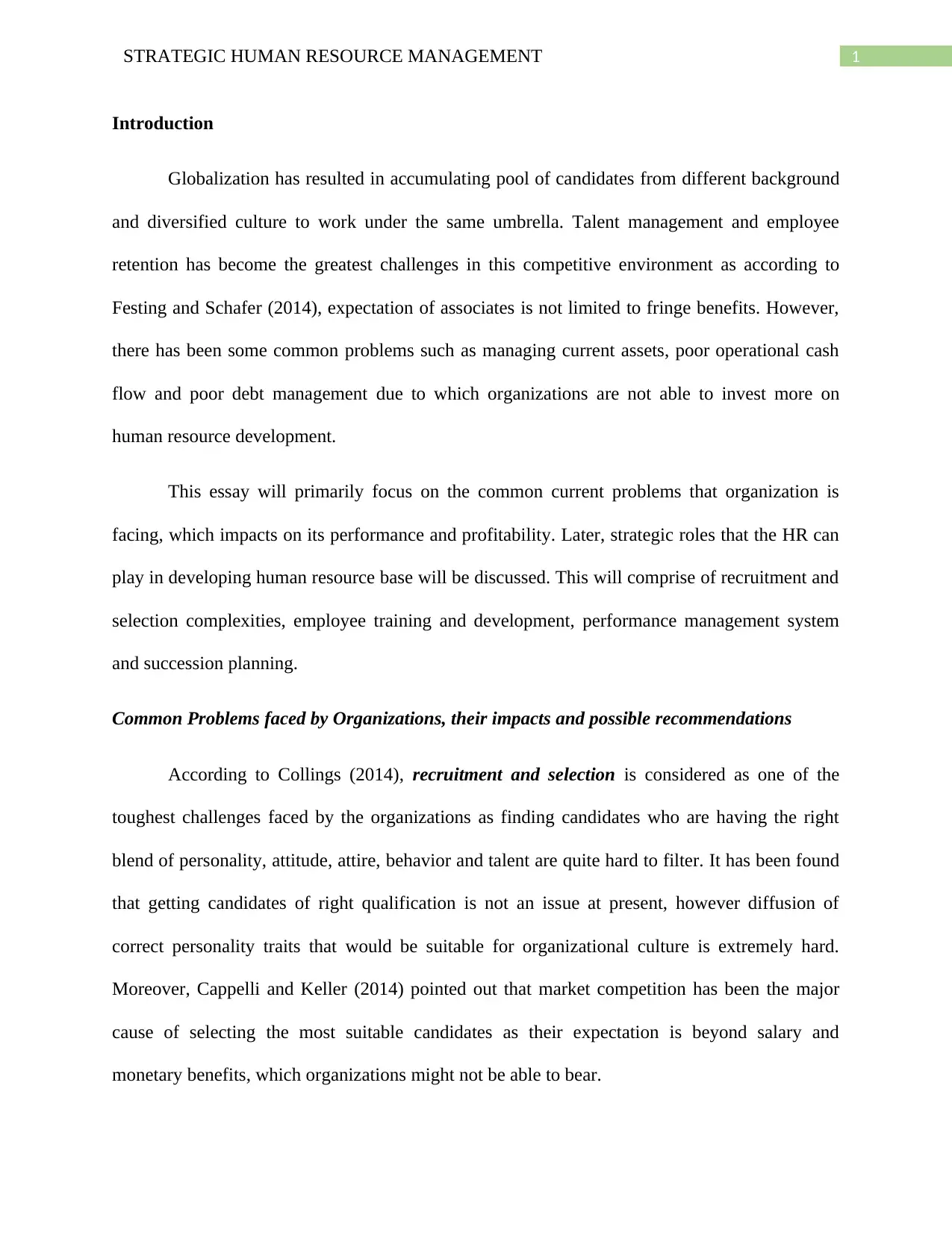
1STRATEGIC HUMAN RESOURCE MANAGEMENT
Introduction
Globalization has resulted in accumulating pool of candidates from different background
and diversified culture to work under the same umbrella. Talent management and employee
retention has become the greatest challenges in this competitive environment as according to
Festing and Schafer (2014), expectation of associates is not limited to fringe benefits. However,
there has been some common problems such as managing current assets, poor operational cash
flow and poor debt management due to which organizations are not able to invest more on
human resource development.
This essay will primarily focus on the common current problems that organization is
facing, which impacts on its performance and profitability. Later, strategic roles that the HR can
play in developing human resource base will be discussed. This will comprise of recruitment and
selection complexities, employee training and development, performance management system
and succession planning.
Common Problems faced by Organizations, their impacts and possible recommendations
According to Collings (2014), recruitment and selection is considered as one of the
toughest challenges faced by the organizations as finding candidates who are having the right
blend of personality, attitude, attire, behavior and talent are quite hard to filter. It has been found
that getting candidates of right qualification is not an issue at present, however diffusion of
correct personality traits that would be suitable for organizational culture is extremely hard.
Moreover, Cappelli and Keller (2014) pointed out that market competition has been the major
cause of selecting the most suitable candidates as their expectation is beyond salary and
monetary benefits, which organizations might not be able to bear.
Introduction
Globalization has resulted in accumulating pool of candidates from different background
and diversified culture to work under the same umbrella. Talent management and employee
retention has become the greatest challenges in this competitive environment as according to
Festing and Schafer (2014), expectation of associates is not limited to fringe benefits. However,
there has been some common problems such as managing current assets, poor operational cash
flow and poor debt management due to which organizations are not able to invest more on
human resource development.
This essay will primarily focus on the common current problems that organization is
facing, which impacts on its performance and profitability. Later, strategic roles that the HR can
play in developing human resource base will be discussed. This will comprise of recruitment and
selection complexities, employee training and development, performance management system
and succession planning.
Common Problems faced by Organizations, their impacts and possible recommendations
According to Collings (2014), recruitment and selection is considered as one of the
toughest challenges faced by the organizations as finding candidates who are having the right
blend of personality, attitude, attire, behavior and talent are quite hard to filter. It has been found
that getting candidates of right qualification is not an issue at present, however diffusion of
correct personality traits that would be suitable for organizational culture is extremely hard.
Moreover, Cappelli and Keller (2014) pointed out that market competition has been the major
cause of selecting the most suitable candidates as their expectation is beyond salary and
monetary benefits, which organizations might not be able to bear.
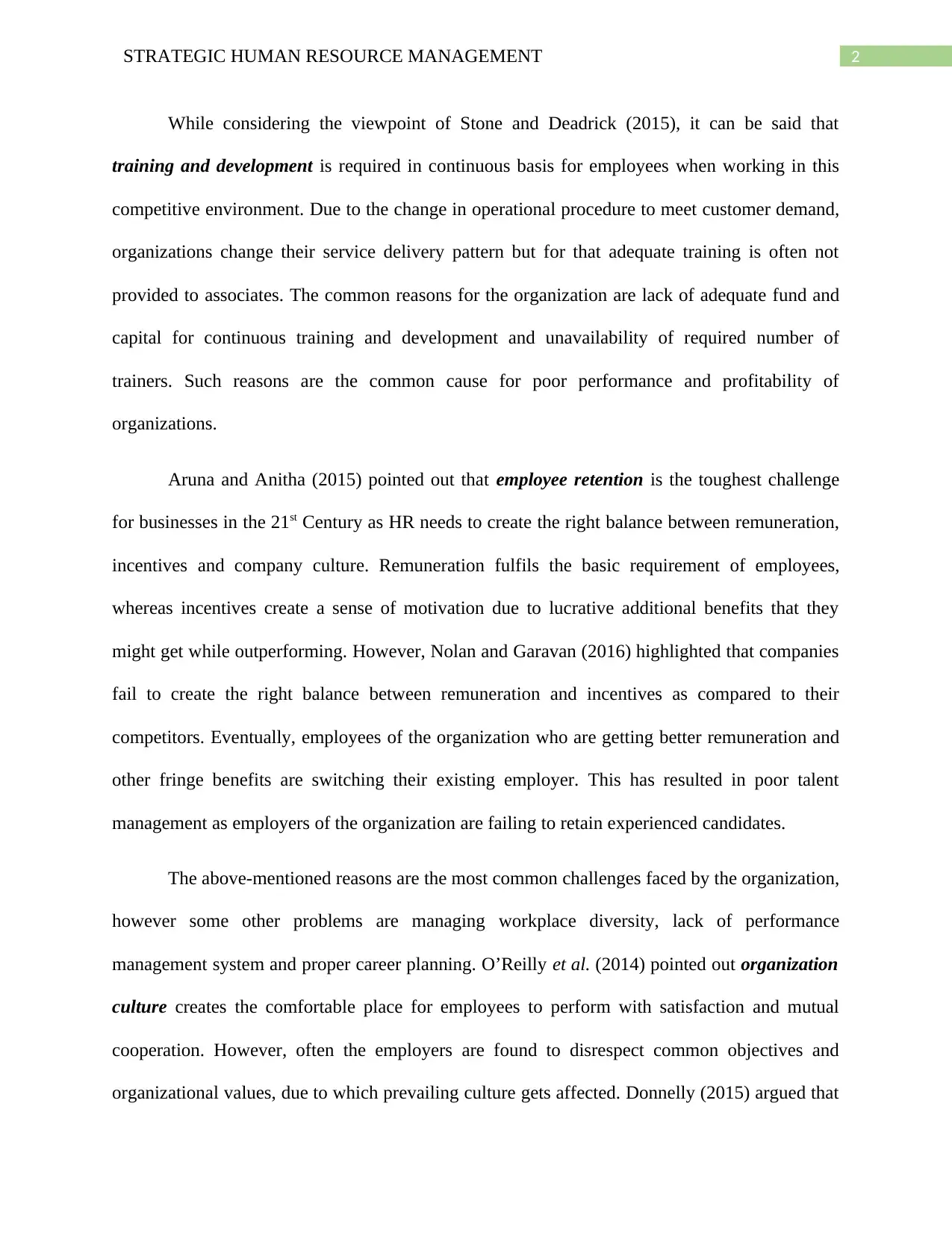
2STRATEGIC HUMAN RESOURCE MANAGEMENT
While considering the viewpoint of Stone and Deadrick (2015), it can be said that
training and development is required in continuous basis for employees when working in this
competitive environment. Due to the change in operational procedure to meet customer demand,
organizations change their service delivery pattern but for that adequate training is often not
provided to associates. The common reasons for the organization are lack of adequate fund and
capital for continuous training and development and unavailability of required number of
trainers. Such reasons are the common cause for poor performance and profitability of
organizations.
Aruna and Anitha (2015) pointed out that employee retention is the toughest challenge
for businesses in the 21st Century as HR needs to create the right balance between remuneration,
incentives and company culture. Remuneration fulfils the basic requirement of employees,
whereas incentives create a sense of motivation due to lucrative additional benefits that they
might get while outperforming. However, Nolan and Garavan (2016) highlighted that companies
fail to create the right balance between remuneration and incentives as compared to their
competitors. Eventually, employees of the organization who are getting better remuneration and
other fringe benefits are switching their existing employer. This has resulted in poor talent
management as employers of the organization are failing to retain experienced candidates.
The above-mentioned reasons are the most common challenges faced by the organization,
however some other problems are managing workplace diversity, lack of performance
management system and proper career planning. O’Reilly et al. (2014) pointed out organization
culture creates the comfortable place for employees to perform with satisfaction and mutual
cooperation. However, often the employers are found to disrespect common objectives and
organizational values, due to which prevailing culture gets affected. Donnelly (2015) argued that
While considering the viewpoint of Stone and Deadrick (2015), it can be said that
training and development is required in continuous basis for employees when working in this
competitive environment. Due to the change in operational procedure to meet customer demand,
organizations change their service delivery pattern but for that adequate training is often not
provided to associates. The common reasons for the organization are lack of adequate fund and
capital for continuous training and development and unavailability of required number of
trainers. Such reasons are the common cause for poor performance and profitability of
organizations.
Aruna and Anitha (2015) pointed out that employee retention is the toughest challenge
for businesses in the 21st Century as HR needs to create the right balance between remuneration,
incentives and company culture. Remuneration fulfils the basic requirement of employees,
whereas incentives create a sense of motivation due to lucrative additional benefits that they
might get while outperforming. However, Nolan and Garavan (2016) highlighted that companies
fail to create the right balance between remuneration and incentives as compared to their
competitors. Eventually, employees of the organization who are getting better remuneration and
other fringe benefits are switching their existing employer. This has resulted in poor talent
management as employers of the organization are failing to retain experienced candidates.
The above-mentioned reasons are the most common challenges faced by the organization,
however some other problems are managing workplace diversity, lack of performance
management system and proper career planning. O’Reilly et al. (2014) pointed out organization
culture creates the comfortable place for employees to perform with satisfaction and mutual
cooperation. However, often the employers are found to disrespect common objectives and
organizational values, due to which prevailing culture gets affected. Donnelly (2015) argued that
⊘ This is a preview!⊘
Do you want full access?
Subscribe today to unlock all pages.

Trusted by 1+ million students worldwide
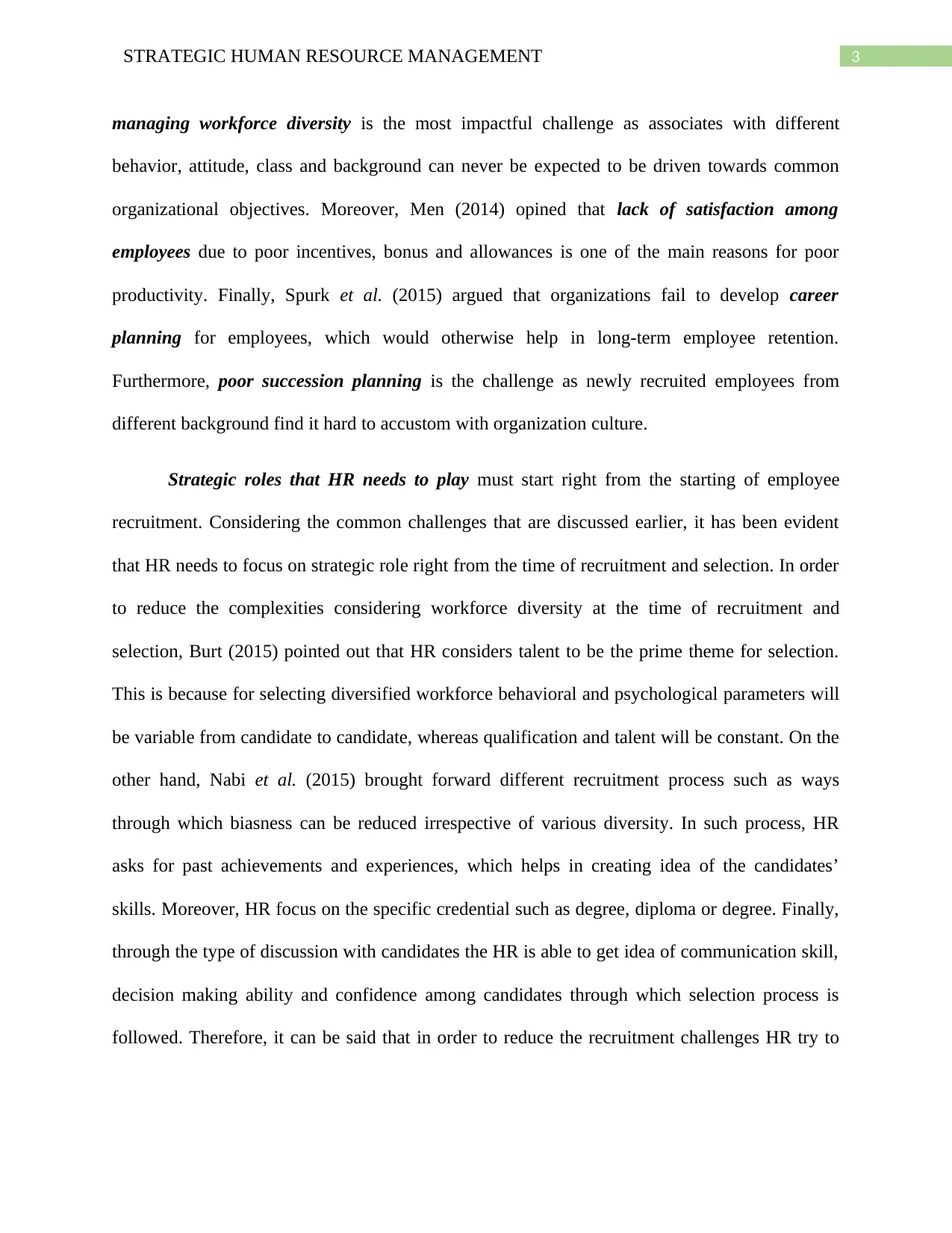
3STRATEGIC HUMAN RESOURCE MANAGEMENT
managing workforce diversity is the most impactful challenge as associates with different
behavior, attitude, class and background can never be expected to be driven towards common
organizational objectives. Moreover, Men (2014) opined that lack of satisfaction among
employees due to poor incentives, bonus and allowances is one of the main reasons for poor
productivity. Finally, Spurk et al. (2015) argued that organizations fail to develop career
planning for employees, which would otherwise help in long-term employee retention.
Furthermore, poor succession planning is the challenge as newly recruited employees from
different background find it hard to accustom with organization culture.
Strategic roles that HR needs to play must start right from the starting of employee
recruitment. Considering the common challenges that are discussed earlier, it has been evident
that HR needs to focus on strategic role right from the time of recruitment and selection. In order
to reduce the complexities considering workforce diversity at the time of recruitment and
selection, Burt (2015) pointed out that HR considers talent to be the prime theme for selection.
This is because for selecting diversified workforce behavioral and psychological parameters will
be variable from candidate to candidate, whereas qualification and talent will be constant. On the
other hand, Nabi et al. (2015) brought forward different recruitment process such as ways
through which biasness can be reduced irrespective of various diversity. In such process, HR
asks for past achievements and experiences, which helps in creating idea of the candidates’
skills. Moreover, HR focus on the specific credential such as degree, diploma or degree. Finally,
through the type of discussion with candidates the HR is able to get idea of communication skill,
decision making ability and confidence among candidates through which selection process is
followed. Therefore, it can be said that in order to reduce the recruitment challenges HR try to
managing workforce diversity is the most impactful challenge as associates with different
behavior, attitude, class and background can never be expected to be driven towards common
organizational objectives. Moreover, Men (2014) opined that lack of satisfaction among
employees due to poor incentives, bonus and allowances is one of the main reasons for poor
productivity. Finally, Spurk et al. (2015) argued that organizations fail to develop career
planning for employees, which would otherwise help in long-term employee retention.
Furthermore, poor succession planning is the challenge as newly recruited employees from
different background find it hard to accustom with organization culture.
Strategic roles that HR needs to play must start right from the starting of employee
recruitment. Considering the common challenges that are discussed earlier, it has been evident
that HR needs to focus on strategic role right from the time of recruitment and selection. In order
to reduce the complexities considering workforce diversity at the time of recruitment and
selection, Burt (2015) pointed out that HR considers talent to be the prime theme for selection.
This is because for selecting diversified workforce behavioral and psychological parameters will
be variable from candidate to candidate, whereas qualification and talent will be constant. On the
other hand, Nabi et al. (2015) brought forward different recruitment process such as ways
through which biasness can be reduced irrespective of various diversity. In such process, HR
asks for past achievements and experiences, which helps in creating idea of the candidates’
skills. Moreover, HR focus on the specific credential such as degree, diploma or degree. Finally,
through the type of discussion with candidates the HR is able to get idea of communication skill,
decision making ability and confidence among candidates through which selection process is
followed. Therefore, it can be said that in order to reduce the recruitment challenges HR try to
Paraphrase This Document
Need a fresh take? Get an instant paraphrase of this document with our AI Paraphraser
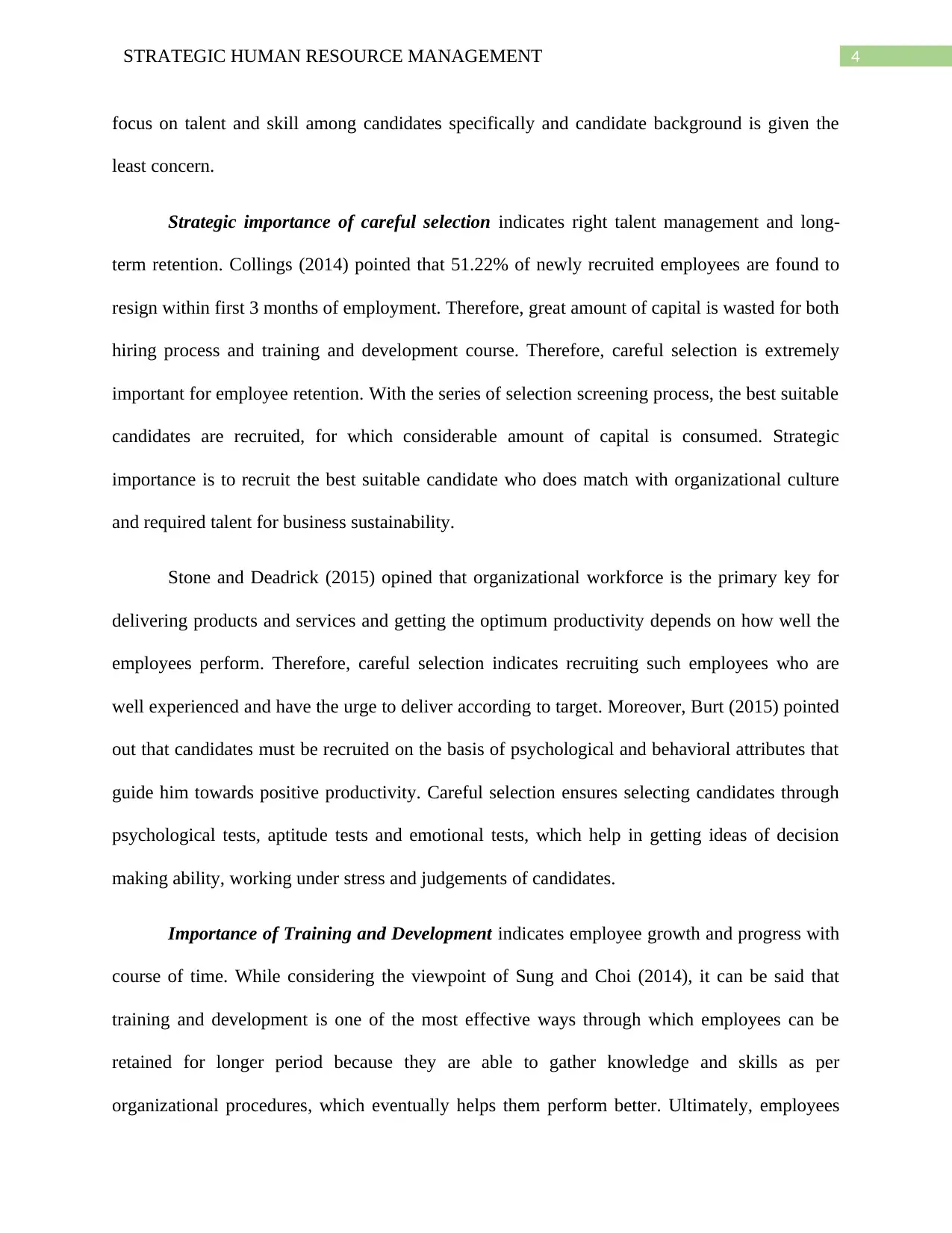
4STRATEGIC HUMAN RESOURCE MANAGEMENT
focus on talent and skill among candidates specifically and candidate background is given the
least concern.
Strategic importance of careful selection indicates right talent management and long-
term retention. Collings (2014) pointed that 51.22% of newly recruited employees are found to
resign within first 3 months of employment. Therefore, great amount of capital is wasted for both
hiring process and training and development course. Therefore, careful selection is extremely
important for employee retention. With the series of selection screening process, the best suitable
candidates are recruited, for which considerable amount of capital is consumed. Strategic
importance is to recruit the best suitable candidate who does match with organizational culture
and required talent for business sustainability.
Stone and Deadrick (2015) opined that organizational workforce is the primary key for
delivering products and services and getting the optimum productivity depends on how well the
employees perform. Therefore, careful selection indicates recruiting such employees who are
well experienced and have the urge to deliver according to target. Moreover, Burt (2015) pointed
out that candidates must be recruited on the basis of psychological and behavioral attributes that
guide him towards positive productivity. Careful selection ensures selecting candidates through
psychological tests, aptitude tests and emotional tests, which help in getting ideas of decision
making ability, working under stress and judgements of candidates.
Importance of Training and Development indicates employee growth and progress with
course of time. While considering the viewpoint of Sung and Choi (2014), it can be said that
training and development is one of the most effective ways through which employees can be
retained for longer period because they are able to gather knowledge and skills as per
organizational procedures, which eventually helps them perform better. Ultimately, employees
focus on talent and skill among candidates specifically and candidate background is given the
least concern.
Strategic importance of careful selection indicates right talent management and long-
term retention. Collings (2014) pointed that 51.22% of newly recruited employees are found to
resign within first 3 months of employment. Therefore, great amount of capital is wasted for both
hiring process and training and development course. Therefore, careful selection is extremely
important for employee retention. With the series of selection screening process, the best suitable
candidates are recruited, for which considerable amount of capital is consumed. Strategic
importance is to recruit the best suitable candidate who does match with organizational culture
and required talent for business sustainability.
Stone and Deadrick (2015) opined that organizational workforce is the primary key for
delivering products and services and getting the optimum productivity depends on how well the
employees perform. Therefore, careful selection indicates recruiting such employees who are
well experienced and have the urge to deliver according to target. Moreover, Burt (2015) pointed
out that candidates must be recruited on the basis of psychological and behavioral attributes that
guide him towards positive productivity. Careful selection ensures selecting candidates through
psychological tests, aptitude tests and emotional tests, which help in getting ideas of decision
making ability, working under stress and judgements of candidates.
Importance of Training and Development indicates employee growth and progress with
course of time. While considering the viewpoint of Sung and Choi (2014), it can be said that
training and development is one of the most effective ways through which employees can be
retained for longer period because they are able to gather knowledge and skills as per
organizational procedures, which eventually helps them perform better. Ultimately, employees
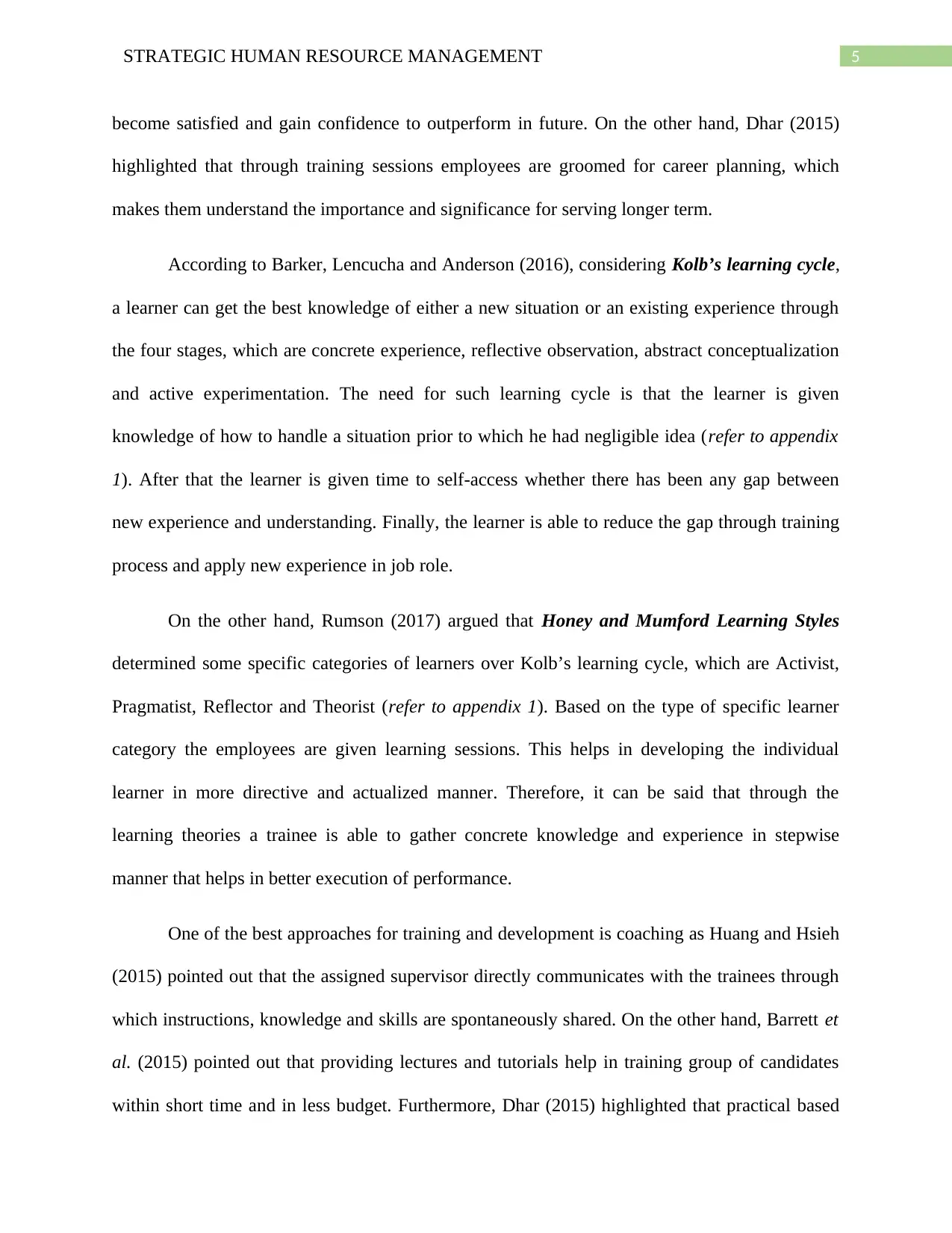
5STRATEGIC HUMAN RESOURCE MANAGEMENT
become satisfied and gain confidence to outperform in future. On the other hand, Dhar (2015)
highlighted that through training sessions employees are groomed for career planning, which
makes them understand the importance and significance for serving longer term.
According to Barker, Lencucha and Anderson (2016), considering Kolb’s learning cycle,
a learner can get the best knowledge of either a new situation or an existing experience through
the four stages, which are concrete experience, reflective observation, abstract conceptualization
and active experimentation. The need for such learning cycle is that the learner is given
knowledge of how to handle a situation prior to which he had negligible idea (refer to appendix
1). After that the learner is given time to self-access whether there has been any gap between
new experience and understanding. Finally, the learner is able to reduce the gap through training
process and apply new experience in job role.
On the other hand, Rumson (2017) argued that Honey and Mumford Learning Styles
determined some specific categories of learners over Kolb’s learning cycle, which are Activist,
Pragmatist, Reflector and Theorist (refer to appendix 1). Based on the type of specific learner
category the employees are given learning sessions. This helps in developing the individual
learner in more directive and actualized manner. Therefore, it can be said that through the
learning theories a trainee is able to gather concrete knowledge and experience in stepwise
manner that helps in better execution of performance.
One of the best approaches for training and development is coaching as Huang and Hsieh
(2015) pointed out that the assigned supervisor directly communicates with the trainees through
which instructions, knowledge and skills are spontaneously shared. On the other hand, Barrett et
al. (2015) pointed out that providing lectures and tutorials help in training group of candidates
within short time and in less budget. Furthermore, Dhar (2015) highlighted that practical based
become satisfied and gain confidence to outperform in future. On the other hand, Dhar (2015)
highlighted that through training sessions employees are groomed for career planning, which
makes them understand the importance and significance for serving longer term.
According to Barker, Lencucha and Anderson (2016), considering Kolb’s learning cycle,
a learner can get the best knowledge of either a new situation or an existing experience through
the four stages, which are concrete experience, reflective observation, abstract conceptualization
and active experimentation. The need for such learning cycle is that the learner is given
knowledge of how to handle a situation prior to which he had negligible idea (refer to appendix
1). After that the learner is given time to self-access whether there has been any gap between
new experience and understanding. Finally, the learner is able to reduce the gap through training
process and apply new experience in job role.
On the other hand, Rumson (2017) argued that Honey and Mumford Learning Styles
determined some specific categories of learners over Kolb’s learning cycle, which are Activist,
Pragmatist, Reflector and Theorist (refer to appendix 1). Based on the type of specific learner
category the employees are given learning sessions. This helps in developing the individual
learner in more directive and actualized manner. Therefore, it can be said that through the
learning theories a trainee is able to gather concrete knowledge and experience in stepwise
manner that helps in better execution of performance.
One of the best approaches for training and development is coaching as Huang and Hsieh
(2015) pointed out that the assigned supervisor directly communicates with the trainees through
which instructions, knowledge and skills are spontaneously shared. On the other hand, Barrett et
al. (2015) pointed out that providing lectures and tutorials help in training group of candidates
within short time and in less budget. Furthermore, Dhar (2015) highlighted that practical based
⊘ This is a preview!⊘
Do you want full access?
Subscribe today to unlock all pages.

Trusted by 1+ million students worldwide
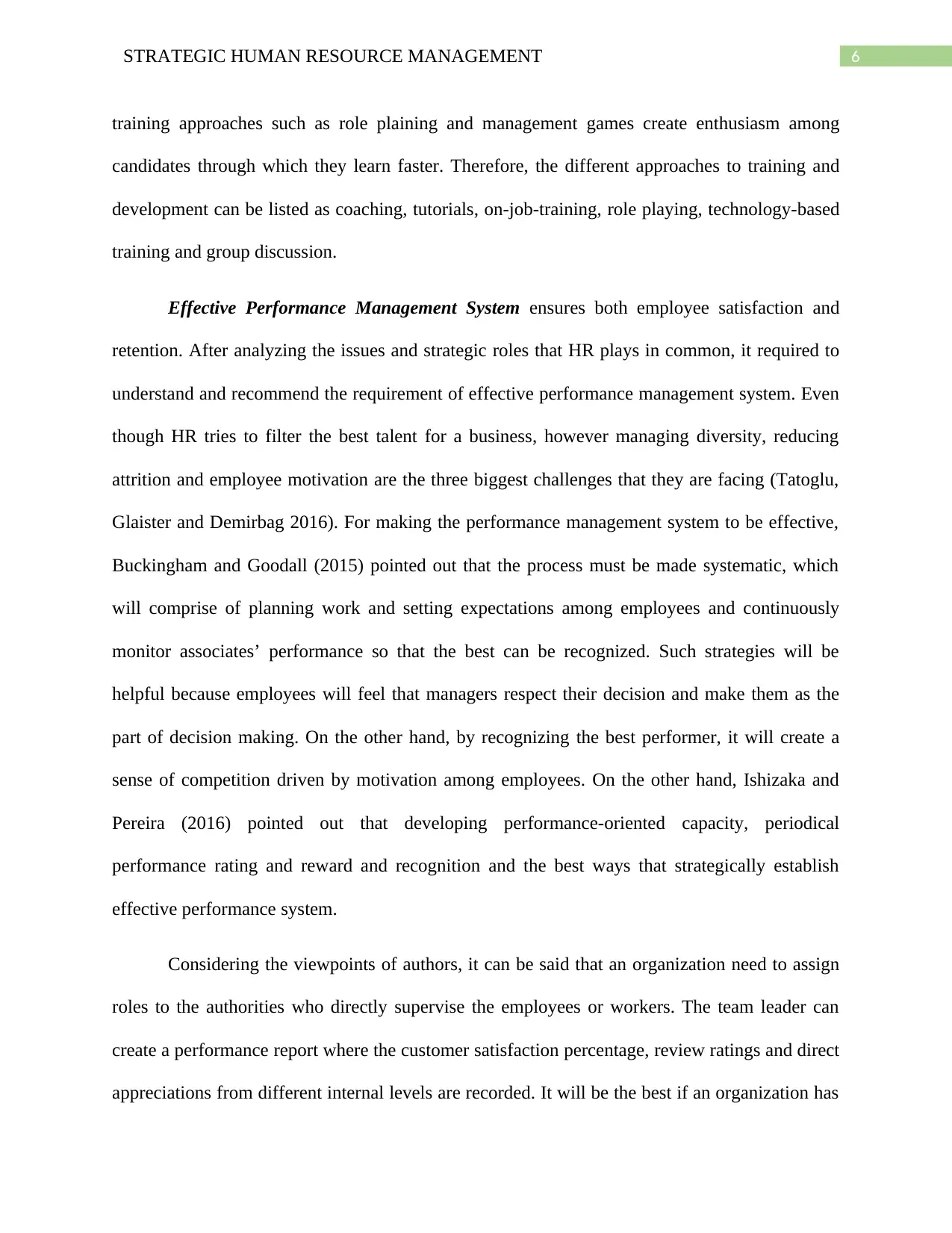
6STRATEGIC HUMAN RESOURCE MANAGEMENT
training approaches such as role plaining and management games create enthusiasm among
candidates through which they learn faster. Therefore, the different approaches to training and
development can be listed as coaching, tutorials, on-job-training, role playing, technology-based
training and group discussion.
Effective Performance Management System ensures both employee satisfaction and
retention. After analyzing the issues and strategic roles that HR plays in common, it required to
understand and recommend the requirement of effective performance management system. Even
though HR tries to filter the best talent for a business, however managing diversity, reducing
attrition and employee motivation are the three biggest challenges that they are facing (Tatoglu,
Glaister and Demirbag 2016). For making the performance management system to be effective,
Buckingham and Goodall (2015) pointed out that the process must be made systematic, which
will comprise of planning work and setting expectations among employees and continuously
monitor associates’ performance so that the best can be recognized. Such strategies will be
helpful because employees will feel that managers respect their decision and make them as the
part of decision making. On the other hand, by recognizing the best performer, it will create a
sense of competition driven by motivation among employees. On the other hand, Ishizaka and
Pereira (2016) pointed out that developing performance-oriented capacity, periodical
performance rating and reward and recognition and the best ways that strategically establish
effective performance system.
Considering the viewpoints of authors, it can be said that an organization need to assign
roles to the authorities who directly supervise the employees or workers. The team leader can
create a performance report where the customer satisfaction percentage, review ratings and direct
appreciations from different internal levels are recorded. It will be the best if an organization has
training approaches such as role plaining and management games create enthusiasm among
candidates through which they learn faster. Therefore, the different approaches to training and
development can be listed as coaching, tutorials, on-job-training, role playing, technology-based
training and group discussion.
Effective Performance Management System ensures both employee satisfaction and
retention. After analyzing the issues and strategic roles that HR plays in common, it required to
understand and recommend the requirement of effective performance management system. Even
though HR tries to filter the best talent for a business, however managing diversity, reducing
attrition and employee motivation are the three biggest challenges that they are facing (Tatoglu,
Glaister and Demirbag 2016). For making the performance management system to be effective,
Buckingham and Goodall (2015) pointed out that the process must be made systematic, which
will comprise of planning work and setting expectations among employees and continuously
monitor associates’ performance so that the best can be recognized. Such strategies will be
helpful because employees will feel that managers respect their decision and make them as the
part of decision making. On the other hand, by recognizing the best performer, it will create a
sense of competition driven by motivation among employees. On the other hand, Ishizaka and
Pereira (2016) pointed out that developing performance-oriented capacity, periodical
performance rating and reward and recognition and the best ways that strategically establish
effective performance system.
Considering the viewpoints of authors, it can be said that an organization need to assign
roles to the authorities who directly supervise the employees or workers. The team leader can
create a performance report where the customer satisfaction percentage, review ratings and direct
appreciations from different internal levels are recorded. It will be the best if an organization has
Paraphrase This Document
Need a fresh take? Get an instant paraphrase of this document with our AI Paraphraser
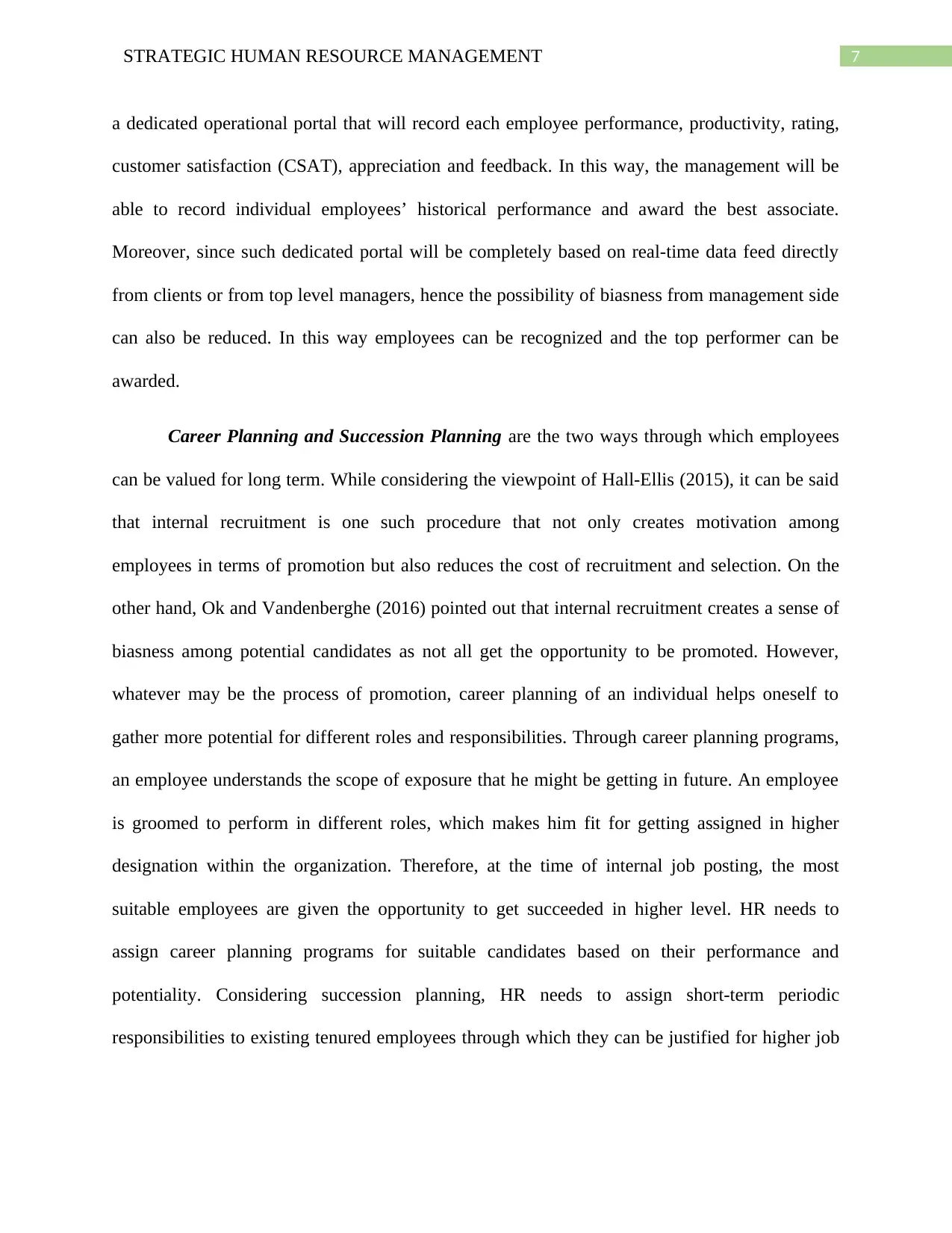
7STRATEGIC HUMAN RESOURCE MANAGEMENT
a dedicated operational portal that will record each employee performance, productivity, rating,
customer satisfaction (CSAT), appreciation and feedback. In this way, the management will be
able to record individual employees’ historical performance and award the best associate.
Moreover, since such dedicated portal will be completely based on real-time data feed directly
from clients or from top level managers, hence the possibility of biasness from management side
can also be reduced. In this way employees can be recognized and the top performer can be
awarded.
Career Planning and Succession Planning are the two ways through which employees
can be valued for long term. While considering the viewpoint of Hall-Ellis (2015), it can be said
that internal recruitment is one such procedure that not only creates motivation among
employees in terms of promotion but also reduces the cost of recruitment and selection. On the
other hand, Ok and Vandenberghe (2016) pointed out that internal recruitment creates a sense of
biasness among potential candidates as not all get the opportunity to be promoted. However,
whatever may be the process of promotion, career planning of an individual helps oneself to
gather more potential for different roles and responsibilities. Through career planning programs,
an employee understands the scope of exposure that he might be getting in future. An employee
is groomed to perform in different roles, which makes him fit for getting assigned in higher
designation within the organization. Therefore, at the time of internal job posting, the most
suitable employees are given the opportunity to get succeeded in higher level. HR needs to
assign career planning programs for suitable candidates based on their performance and
potentiality. Considering succession planning, HR needs to assign short-term periodic
responsibilities to existing tenured employees through which they can be justified for higher job
a dedicated operational portal that will record each employee performance, productivity, rating,
customer satisfaction (CSAT), appreciation and feedback. In this way, the management will be
able to record individual employees’ historical performance and award the best associate.
Moreover, since such dedicated portal will be completely based on real-time data feed directly
from clients or from top level managers, hence the possibility of biasness from management side
can also be reduced. In this way employees can be recognized and the top performer can be
awarded.
Career Planning and Succession Planning are the two ways through which employees
can be valued for long term. While considering the viewpoint of Hall-Ellis (2015), it can be said
that internal recruitment is one such procedure that not only creates motivation among
employees in terms of promotion but also reduces the cost of recruitment and selection. On the
other hand, Ok and Vandenberghe (2016) pointed out that internal recruitment creates a sense of
biasness among potential candidates as not all get the opportunity to be promoted. However,
whatever may be the process of promotion, career planning of an individual helps oneself to
gather more potential for different roles and responsibilities. Through career planning programs,
an employee understands the scope of exposure that he might be getting in future. An employee
is groomed to perform in different roles, which makes him fit for getting assigned in higher
designation within the organization. Therefore, at the time of internal job posting, the most
suitable employees are given the opportunity to get succeeded in higher level. HR needs to
assign career planning programs for suitable candidates based on their performance and
potentiality. Considering succession planning, HR needs to assign short-term periodic
responsibilities to existing tenured employees through which they can be justified for higher job
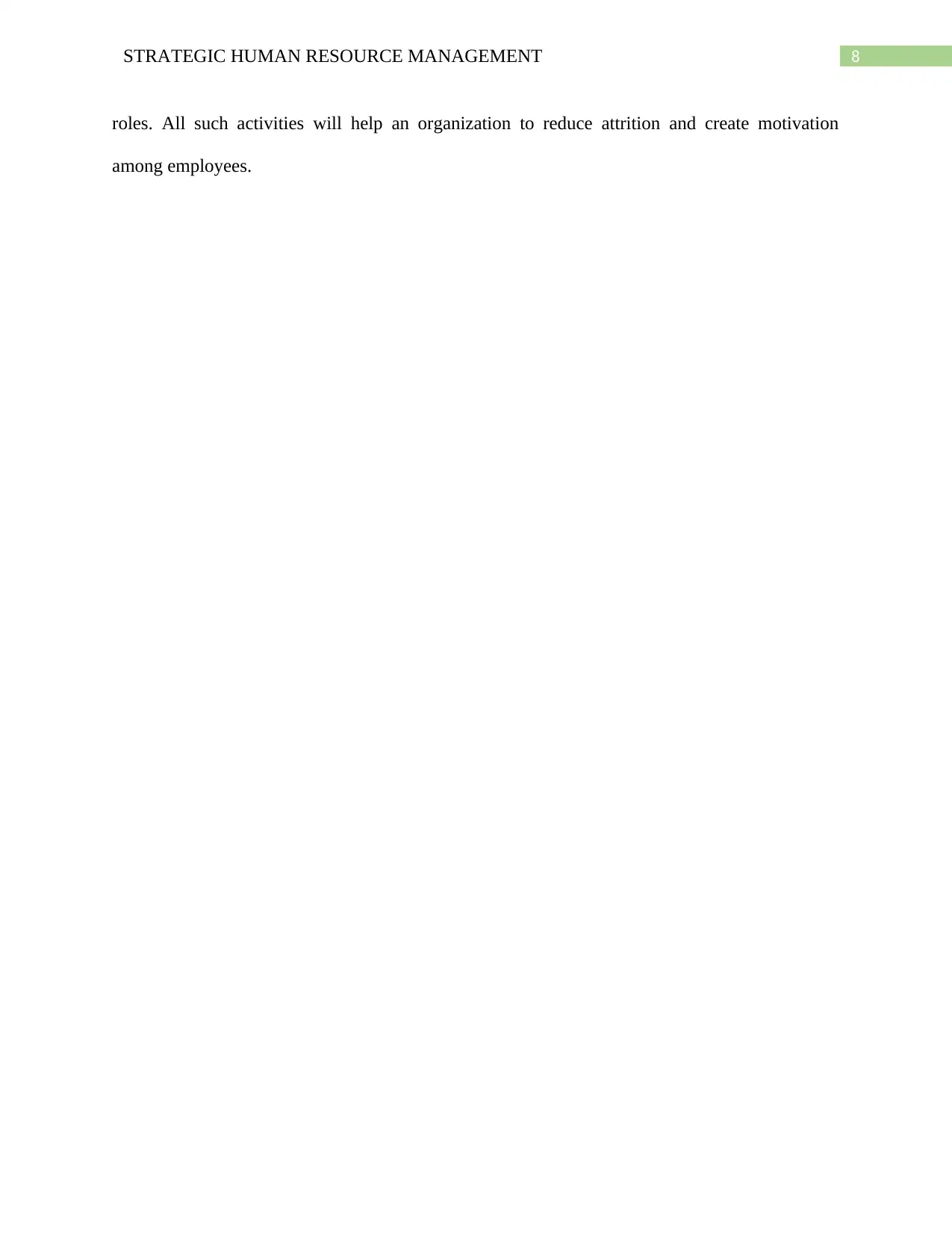
8STRATEGIC HUMAN RESOURCE MANAGEMENT
roles. All such activities will help an organization to reduce attrition and create motivation
among employees.
roles. All such activities will help an organization to reduce attrition and create motivation
among employees.
⊘ This is a preview!⊘
Do you want full access?
Subscribe today to unlock all pages.

Trusted by 1+ million students worldwide
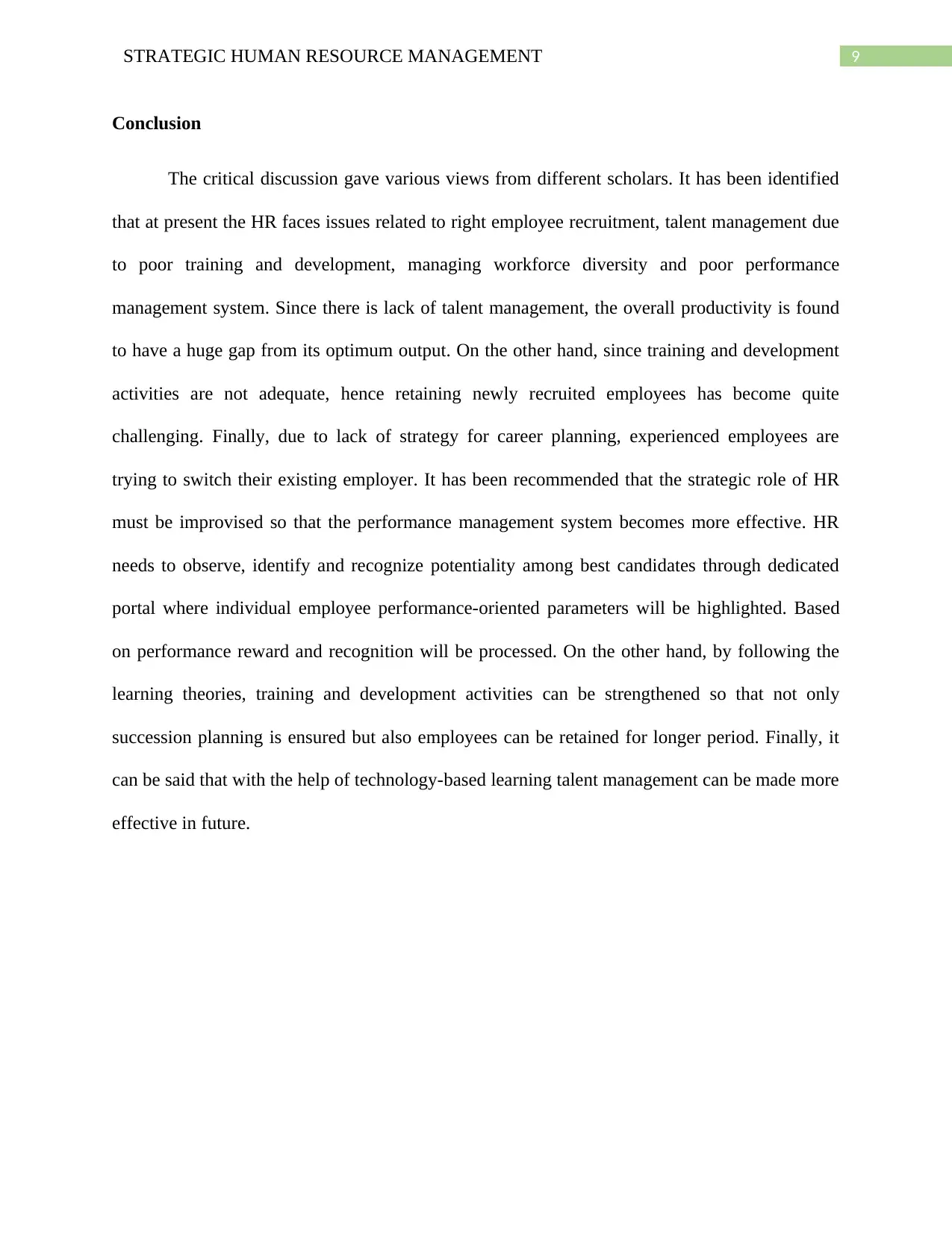
9STRATEGIC HUMAN RESOURCE MANAGEMENT
Conclusion
The critical discussion gave various views from different scholars. It has been identified
that at present the HR faces issues related to right employee recruitment, talent management due
to poor training and development, managing workforce diversity and poor performance
management system. Since there is lack of talent management, the overall productivity is found
to have a huge gap from its optimum output. On the other hand, since training and development
activities are not adequate, hence retaining newly recruited employees has become quite
challenging. Finally, due to lack of strategy for career planning, experienced employees are
trying to switch their existing employer. It has been recommended that the strategic role of HR
must be improvised so that the performance management system becomes more effective. HR
needs to observe, identify and recognize potentiality among best candidates through dedicated
portal where individual employee performance-oriented parameters will be highlighted. Based
on performance reward and recognition will be processed. On the other hand, by following the
learning theories, training and development activities can be strengthened so that not only
succession planning is ensured but also employees can be retained for longer period. Finally, it
can be said that with the help of technology-based learning talent management can be made more
effective in future.
Conclusion
The critical discussion gave various views from different scholars. It has been identified
that at present the HR faces issues related to right employee recruitment, talent management due
to poor training and development, managing workforce diversity and poor performance
management system. Since there is lack of talent management, the overall productivity is found
to have a huge gap from its optimum output. On the other hand, since training and development
activities are not adequate, hence retaining newly recruited employees has become quite
challenging. Finally, due to lack of strategy for career planning, experienced employees are
trying to switch their existing employer. It has been recommended that the strategic role of HR
must be improvised so that the performance management system becomes more effective. HR
needs to observe, identify and recognize potentiality among best candidates through dedicated
portal where individual employee performance-oriented parameters will be highlighted. Based
on performance reward and recognition will be processed. On the other hand, by following the
learning theories, training and development activities can be strengthened so that not only
succession planning is ensured but also employees can be retained for longer period. Finally, it
can be said that with the help of technology-based learning talent management can be made more
effective in future.
Paraphrase This Document
Need a fresh take? Get an instant paraphrase of this document with our AI Paraphraser
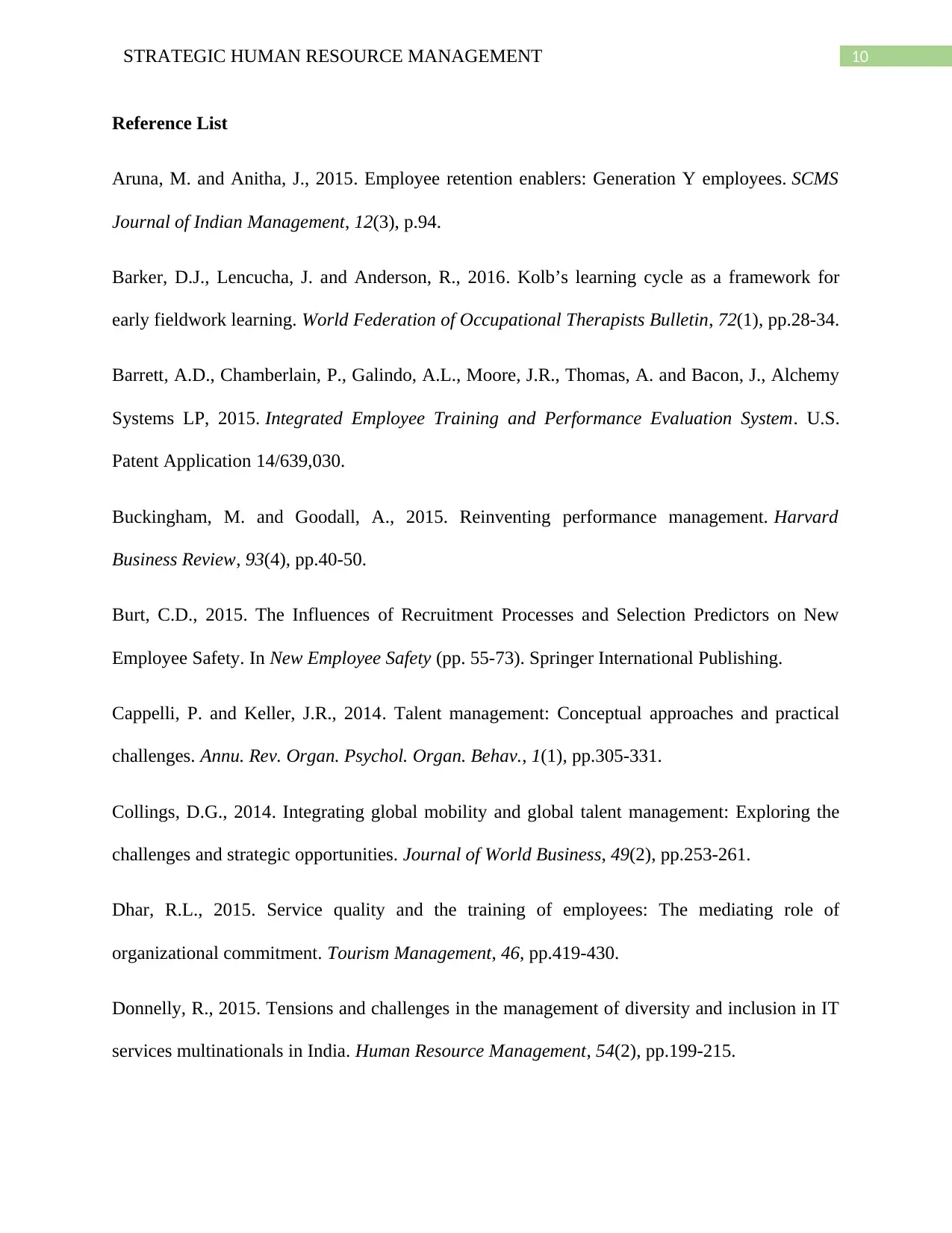
10STRATEGIC HUMAN RESOURCE MANAGEMENT
Reference List
Aruna, M. and Anitha, J., 2015. Employee retention enablers: Generation Y employees. SCMS
Journal of Indian Management, 12(3), p.94.
Barker, D.J., Lencucha, J. and Anderson, R., 2016. Kolb’s learning cycle as a framework for
early fieldwork learning. World Federation of Occupational Therapists Bulletin, 72(1), pp.28-34.
Barrett, A.D., Chamberlain, P., Galindo, A.L., Moore, J.R., Thomas, A. and Bacon, J., Alchemy
Systems LP, 2015. Integrated Employee Training and Performance Evaluation System. U.S.
Patent Application 14/639,030.
Buckingham, M. and Goodall, A., 2015. Reinventing performance management. Harvard
Business Review, 93(4), pp.40-50.
Burt, C.D., 2015. The Influences of Recruitment Processes and Selection Predictors on New
Employee Safety. In New Employee Safety (pp. 55-73). Springer International Publishing.
Cappelli, P. and Keller, J.R., 2014. Talent management: Conceptual approaches and practical
challenges. Annu. Rev. Organ. Psychol. Organ. Behav., 1(1), pp.305-331.
Collings, D.G., 2014. Integrating global mobility and global talent management: Exploring the
challenges and strategic opportunities. Journal of World Business, 49(2), pp.253-261.
Dhar, R.L., 2015. Service quality and the training of employees: The mediating role of
organizational commitment. Tourism Management, 46, pp.419-430.
Donnelly, R., 2015. Tensions and challenges in the management of diversity and inclusion in IT
services multinationals in India. Human Resource Management, 54(2), pp.199-215.
Reference List
Aruna, M. and Anitha, J., 2015. Employee retention enablers: Generation Y employees. SCMS
Journal of Indian Management, 12(3), p.94.
Barker, D.J., Lencucha, J. and Anderson, R., 2016. Kolb’s learning cycle as a framework for
early fieldwork learning. World Federation of Occupational Therapists Bulletin, 72(1), pp.28-34.
Barrett, A.D., Chamberlain, P., Galindo, A.L., Moore, J.R., Thomas, A. and Bacon, J., Alchemy
Systems LP, 2015. Integrated Employee Training and Performance Evaluation System. U.S.
Patent Application 14/639,030.
Buckingham, M. and Goodall, A., 2015. Reinventing performance management. Harvard
Business Review, 93(4), pp.40-50.
Burt, C.D., 2015. The Influences of Recruitment Processes and Selection Predictors on New
Employee Safety. In New Employee Safety (pp. 55-73). Springer International Publishing.
Cappelli, P. and Keller, J.R., 2014. Talent management: Conceptual approaches and practical
challenges. Annu. Rev. Organ. Psychol. Organ. Behav., 1(1), pp.305-331.
Collings, D.G., 2014. Integrating global mobility and global talent management: Exploring the
challenges and strategic opportunities. Journal of World Business, 49(2), pp.253-261.
Dhar, R.L., 2015. Service quality and the training of employees: The mediating role of
organizational commitment. Tourism Management, 46, pp.419-430.
Donnelly, R., 2015. Tensions and challenges in the management of diversity and inclusion in IT
services multinationals in India. Human Resource Management, 54(2), pp.199-215.
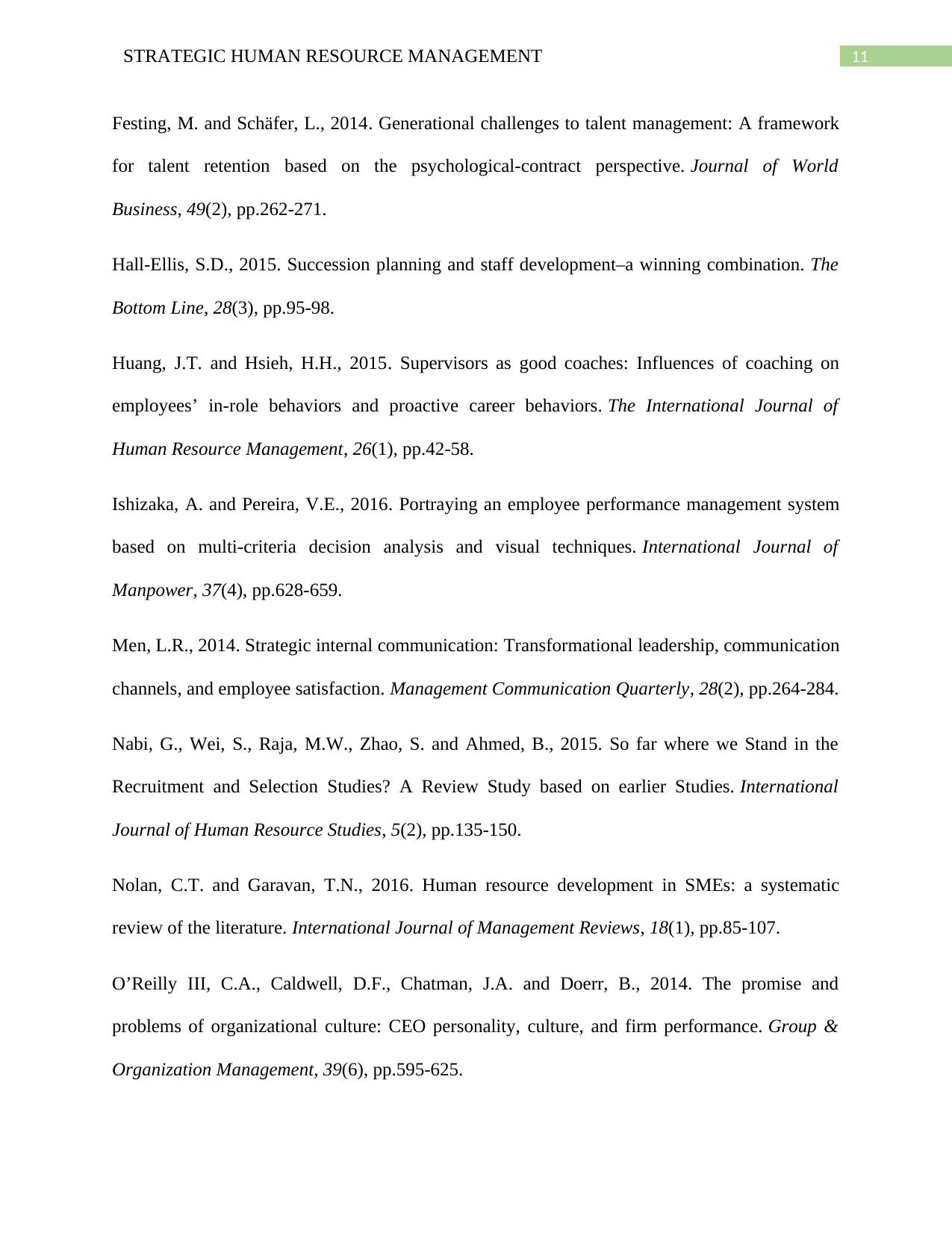
11STRATEGIC HUMAN RESOURCE MANAGEMENT
Festing, M. and Schäfer, L., 2014. Generational challenges to talent management: A framework
for talent retention based on the psychological-contract perspective. Journal of World
Business, 49(2), pp.262-271.
Hall-Ellis, S.D., 2015. Succession planning and staff development–a winning combination. The
Bottom Line, 28(3), pp.95-98.
Huang, J.T. and Hsieh, H.H., 2015. Supervisors as good coaches: Influences of coaching on
employees’ in-role behaviors and proactive career behaviors. The International Journal of
Human Resource Management, 26(1), pp.42-58.
Ishizaka, A. and Pereira, V.E., 2016. Portraying an employee performance management system
based on multi-criteria decision analysis and visual techniques. International Journal of
Manpower, 37(4), pp.628-659.
Men, L.R., 2014. Strategic internal communication: Transformational leadership, communication
channels, and employee satisfaction. Management Communication Quarterly, 28(2), pp.264-284.
Nabi, G., Wei, S., Raja, M.W., Zhao, S. and Ahmed, B., 2015. So far where we Stand in the
Recruitment and Selection Studies? A Review Study based on earlier Studies. International
Journal of Human Resource Studies, 5(2), pp.135-150.
Nolan, C.T. and Garavan, T.N., 2016. Human resource development in SMEs: a systematic
review of the literature. International Journal of Management Reviews, 18(1), pp.85-107.
O’Reilly III, C.A., Caldwell, D.F., Chatman, J.A. and Doerr, B., 2014. The promise and
problems of organizational culture: CEO personality, culture, and firm performance. Group &
Organization Management, 39(6), pp.595-625.
Festing, M. and Schäfer, L., 2014. Generational challenges to talent management: A framework
for talent retention based on the psychological-contract perspective. Journal of World
Business, 49(2), pp.262-271.
Hall-Ellis, S.D., 2015. Succession planning and staff development–a winning combination. The
Bottom Line, 28(3), pp.95-98.
Huang, J.T. and Hsieh, H.H., 2015. Supervisors as good coaches: Influences of coaching on
employees’ in-role behaviors and proactive career behaviors. The International Journal of
Human Resource Management, 26(1), pp.42-58.
Ishizaka, A. and Pereira, V.E., 2016. Portraying an employee performance management system
based on multi-criteria decision analysis and visual techniques. International Journal of
Manpower, 37(4), pp.628-659.
Men, L.R., 2014. Strategic internal communication: Transformational leadership, communication
channels, and employee satisfaction. Management Communication Quarterly, 28(2), pp.264-284.
Nabi, G., Wei, S., Raja, M.W., Zhao, S. and Ahmed, B., 2015. So far where we Stand in the
Recruitment and Selection Studies? A Review Study based on earlier Studies. International
Journal of Human Resource Studies, 5(2), pp.135-150.
Nolan, C.T. and Garavan, T.N., 2016. Human resource development in SMEs: a systematic
review of the literature. International Journal of Management Reviews, 18(1), pp.85-107.
O’Reilly III, C.A., Caldwell, D.F., Chatman, J.A. and Doerr, B., 2014. The promise and
problems of organizational culture: CEO personality, culture, and firm performance. Group &
Organization Management, 39(6), pp.595-625.
⊘ This is a preview!⊘
Do you want full access?
Subscribe today to unlock all pages.

Trusted by 1+ million students worldwide
1 out of 14
Related Documents
Your All-in-One AI-Powered Toolkit for Academic Success.
+13062052269
info@desklib.com
Available 24*7 on WhatsApp / Email
![[object Object]](/_next/static/media/star-bottom.7253800d.svg)
Unlock your academic potential
Copyright © 2020–2025 A2Z Services. All Rights Reserved. Developed and managed by ZUCOL.




